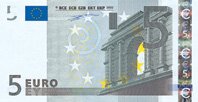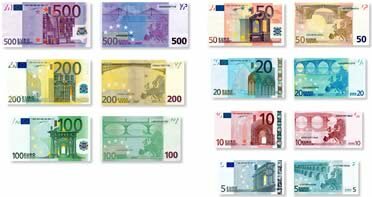Money, Money, Money
by Linda Coffman
Dollars and Sense
 Ah, good old "Yankee Dollars"... so widely accepted that they are all you need in your wallet when sailing to the Bahamas, Bermuda, and Caribbean ports, including most destinations in Mexico. While cruising abroad, though, don't fail to pack some currency savvy along with your passport, guidebooks, and sensible walking shoes.
Ah, good old "Yankee Dollars"... so widely accepted that they are all you need in your wallet when sailing to the Bahamas, Bermuda, and Caribbean ports, including most destinations in Mexico. While cruising abroad, though, don't fail to pack some currency savvy along with your passport, guidebooks, and sensible walking shoes.
When in Europe, you pay with the Euro in European Union (EU) countries and local currency in others. Period! Well, there is American Express, MasterCard, and VISA—all widely accepted, both by merchants and at ATMs, but you still need to know how many Euro (or Pounds or Lira) translate into a dollar. Nothing ruins vacation memories like opening your credit card statement and discovering that the smart leather handbag you bought for $30 really set you back $300.
Penny- AND Pound-wise
One of the first stops to make when your plane lands is an airport currency booth or ATM. If you are on your own, you'll need taxi fare to get to the port or your hotel. Note the current exchange rate posted while you're waiting for your luggage and jot it down in the small notepad you remembered to slip in your tote bag. Knowing at least the approximate conversion rate ahead of time can be a lifesaver at ATMs. You'll want to know whether withdrawing 150 or 300 Euro will yield the equivalent of approximately $10 or nearly $300. Congratulate yourself for being so prepared!
Hint: When changing dollars to local currency at foreign banks while in ports of call, identification is often required. If the ship's purser is holding your passport, carry a copy of it ashore, along with your driver's license or other form of ID.
The EURO made simple
Calling on a half dozen ports, all with different and confusing bills and coins, can be a challenge for American and European cruisers alike. The convenience of the Euro has simplified things since its introduction, but not all countries have adopted it. Those using the Euro are Austria, Belgium, Finland, France, Germany, Greece, Ireland, Italy, Luxembourg, Netherlands, Portugal, and Spain.

Euro notes in denominations €5, €10, €20, €50, €100, €200, and €500 are identical throughout EU countries and can be used anywhere within the EU area, regardless of where they were issued. To facilitate recognition, the notes differ in size and color by denomination with the values printed in large figures. Pictured on the front of Euro notes are windows and gateways that symbolize a spirit of openness. The back of each note features a bridge, which represents co-operation and communication between Europe and the rest of the world.
Like the US dollar, one euro is divided into 100 cents. Eight denominations of coins vary in size, color, and thickness according to their value. They are 1, 2, 5, 10, 20, and 50 cents or €1 and €2. One side of each coin depicts one of three map designs common to all Euro countries. The other side of each coin features individual designs relating to the member country where it was issued. Like Euro notes, Euro coins can be used anywhere in the Euro area, regardless of their nation of origin.
Ashore
Hotel front desks will change dollars to local currency, both pre- and post-cruise. But buyer beware—the rates may not be the most favorable. It's better to visit a currency exchange or a bank that accepts your ATM card as they will yield the best exchange.
In the Mediterranean, strangely there are usually no Maltese Lira available on most ships; however, the Maltese usually accept American dollars without hesitation. On the other hand, Croatian currency is also seldom available on board, yet dollars are not as widely accepted ashore. Local customs vary and you might find merchants in Turkey anxious to conduct commerce in dollars, while a Norwegian coffee shop would rather process a credit card transaction for a purchase as small as two lattes than accept US dollars. For large purchases, a credit card is safe and usually yields the best exchange rate.
Hint: A tiny pocket calculator is invaluable for currency conversion purposes.
On board
On cruise ships that cater primarily to American passengers, US dollars rule the waves. All charges on board are handled as if you'd never left home. Before arrival in foreign ports, the Purser will often set up a Currency Desk and cheerfully change American dollars into local funds. If you don't use it all, simply change the paper money back to dollars or the currency of your next port. You might not get the best rate available, or pay a small service fee, but factor in the convenience and it's often a simple trade-off.
Hint: Only paper money is generally accepted for exchange on most ships.
Yes, Canada is a foreign country
Now, take a look at our northern neighbors. Don't forget, Canada is a foreign country. Americans need proper citizenship identification when entering and leaving Canada and Canadian money. Oh sure, there are places where American dollars are acceptable, but your change will likely be in Canadian currency. Don't be upset and don't argue about it. As a tourist, you are a guest in their country. Besides, Canadian "Loonies" are pretty!
A final hint... shipboard stewards will often be revisiting the intriguing ports of call you just explored on your cruise. Adding a "bonus" of leftover foreign currency to their gratuity envelopes is a nice gesture.
Courtesy of CruiseDiva.com...
 Know what a dollar is really worth in foreign currency before you leave home with a free "Cheat Sheet" for your wallet. From OANDA, the web's premier site for currency conversion, get yours HERE.
Know what a dollar is really worth in foreign currency before you leave home with a free "Cheat Sheet" for your wallet. From OANDA, the web's premier site for currency conversion, get yours HERE.
For advance preparation, also purchase foreign currency online from OANDA, a service of Thomas Cook Currency Services.
Apply for a passport -- Don't wait until the last minute, here's how to apply for your US passport.
More from CruiseDiva.com:
Articles & Advice
Cruise Reviews
Cruise Line Profiles
